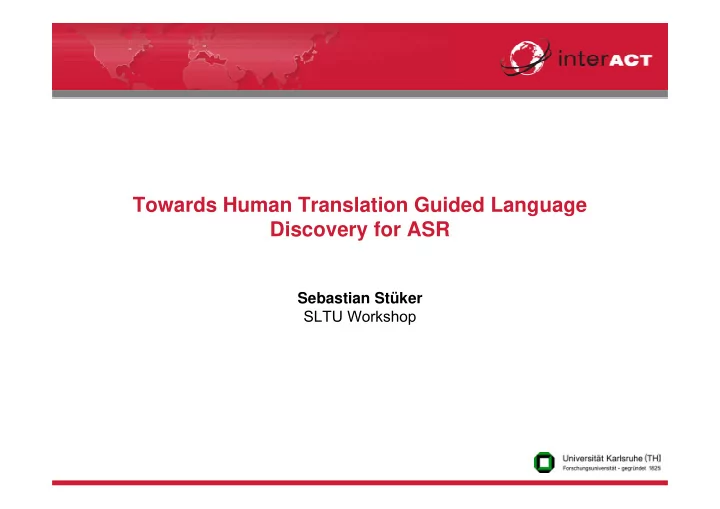

Towards Human Translation Guided Language Discovery for ASR Sebastian Stüker SLTU Workshop
Introduction Training LVCSR systems require large amounts of training data Training the acoustic models requires large amounts of transcribed audio recordings Usually the necessary training material is recorded and then manually transcribed For phoneme based systems a pronunciation dictionary needs to be created: Needs time and money For many languages writing systems do not even exist and would need to be created for an ASR system Often the output of an ASR system is not needed directly but is part of a more complex system, e.g. a speech-to-speech translation system No “correct” word transcription necessary, only one that is suitable for further processing
Collecting Training Data from Translators Instead of manually annotating data on explicitly collected training data, collect the data on the fly Valuable, parallel data for training speech-to-speech translation systems is produced in real-life in human mediated translation scenarios (e.g. two people communication via an interpreter) We assume that one of the languages involved is a well-known language and the other one is an unknown, less prevalent language for which we want to create an ASR system. The speech from the well known language can be transcribed automatically, the speech from the unknown language not. Speech from the unknown language might not even be transcribed on word level, e.g. because no script exists or no expert for transcription. Phoneme Based transcription possible, maybe even automatically. In this work focus on exploratory experiments creating a suitable dictionary from the translation data.
Related Work Besacier et. all proposed speech translation based between phonemes in the less prevalent languages and words in the well known language in 2006 In order to achieve good translation quality they proposed a monolingual word discovery algorithm operating on the phoneme string In our work we try to utilize the parallel information for discovering the words in the phoneme string of the new language.
Word Alignment Word alignments know from the field of statistical machine translation for training the translation model of a recognizer Source string with J words s J = s 1 ,s 2 ,…,s J and target string with I words t I = t 1 ,t 2 ,…,t I A word-to-word A alignment between the two strings is defined as a subset of the Cartesian product of the word positions: Usually each source word assigned to exactly one target word Thus alignments can be written as a = a 1 , … a J
Word Alignment Alignments can be found with the help of statistical alignment and statistical translation models from SMT Similar as in ASR the probability in SMT is composed of a language model and a translation model P(s J |t I ) Incorporating an alignment between s J and t J gives a statistical alignment mode P(s J a J |t J ) The translation probability can be expressed as Alignment probability usually depends on a set of parameters Θ Best set of parameters found on parallel data using EM training
Word Alignment Using the learned parameters one can find the most likely alignment between two sentences Different models exist, e.g. IBM 1-5, HMM models, hybrid models etc. Used IBM 4 Models for our experiments
Measuring Alignment Quality For measuring the quality of found alignments one can use the alignment error rate (AER) Uses manually aligned sentence pairs as references Alignments a j are not unambiguous S ⊆ a j labeled as either sure (S) or possible (P), P Precision and recall for an alignment can now be determined AER is derived from the F-Measure
Data Worked an English-Spanish version of the Basic Travel Expression Corpus (BTEC) English takes the role of the well known language, Spanish takes the role of the less prevalent language 155K parallel sentences, 12K English vocabulary, 20K Spanish vocabulary Removed sentences that were longer than 50 words, phonemes respectively Removed pairs exceeding sentence length ration of 9-1
Word to Phoneme Alignment Used GIZA++ and Pharao training script for training IBM-4 models Trained model for word-to-word alignment (reference) and word-to-phoneme alignment Degradation compared to words but still reasonable
Examples
Dictionary Extraction Only use alignment direction from Spanish phonemes to English words Every English word that is mapped to a phoneme sequence is a potential “Spanish” words Words mapped to the same sequence are merged Words mapped to none consecutive sequences are split Resulting dictionary contains 16K words 5,400 words have an exact, phonetic match in the original dictionary
Outlook End-to-End evaluation Take inverse alignment direction and heuristics into consideration Merge with approach from Besacier et. al. for word discovery
Recommend
More recommend